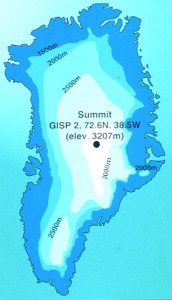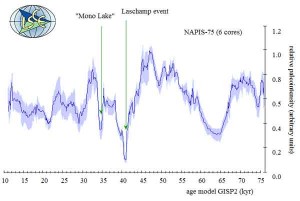In the most recent Magnetic Personalities meeting we looked at a paper published in Quaternary Science Reviews in 2005 entitled “Geomagnetic Field intensity during the last 60,000 years based on 10Be and 36Cl from the Summit ice cores and 14C” by the authors Raimund Muscheler et al. I chose this paper as I thought it would be interesting to discuss a paper that approaches the problem of geomagnetic field reconstruction in a very different way.
last 60,000 years based on 10Be and 36Cl from the Summit ice cores and 14C” by the authors Raimund Muscheler et al. I chose this paper as I thought it would be interesting to discuss a paper that approaches the problem of geomagnetic field reconstruction in a very different way.
The authors reconstructed past changes in the geomagnetic field intensity based on 10Be, 36Cl and 14C records under the assumption that radionuclide records are mainly influenced by changes in their production rates. Most reconstructions of the geomagnetic field intensity are based on the natural remanent magnetisation acquired by ceramics, volcanic rocks or lacustrine and marine sediments.
Cosmogenic radionuclides (e.g. 10Be, 36Cl and 14C) are produced in the Earth’s atmosphere by the interaction of galactic cosmic rays with the atoms of the atmosphere. The connection between cosmogenic radionuclide production and the Earth’s magnetic field is as follows: the higher the geomagnetic field intensity, the stronger the deflection of the primary cosmic ray particles that consist mainly of protons and α-particles. As a consequence, less cosmogenic radionuclides are produced during periods of high geomagnetic field intensity and more are produced in low geomagnetic field intensities. There are a number of other factors that could influence cosmogenic radionuclide which the authors detail in the paper.
By combining the data from the GRIP and GISP2 ice cores from Central Greenland,  it is possible to obtain a continuous record of the deposition of cosmogenic radionuclides in Greenland for the last 60,000 years. As a group we discussed the results and generally were more convinced by the trends seen in the 10Be results than the other radionuclides. We also discussed how well the Laschamp geomagnetic excursion showed up in the data, an event which was first reported in 1969 by Bonhommet and Zähringer.
it is possible to obtain a continuous record of the deposition of cosmogenic radionuclides in Greenland for the last 60,000 years. As a group we discussed the results and generally were more convinced by the trends seen in the 10Be results than the other radionuclides. We also discussed how well the Laschamp geomagnetic excursion showed up in the data, an event which was first reported in 1969 by Bonhommet and Zähringer.
All in all, it was a very interesting paper to study and its always good to sit in the sunshine and discuss a paper that tackles a problem in an interesting way!

Leave a Reply